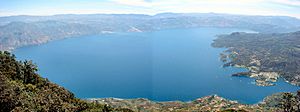Santiago Atitlán facts for kids
Quick facts for kids
Santiago Atitlán
Tz'ikin Jaay
|
|
|---|---|
|
City
|
|

Santiago (on right) and Lake Atitlán from Volcan San Pedro
|
|
| Country | |
| Department | |
| Elevation | 1,567 m (5,141 ft) |
| Highest elevation | 3,516 m (11,535 ft) |
| Lowest elevation | 1,562 m (5,125 ft) |
| Time zone | UTC-6 (Central Time) |
| Country calling code | 502 |
| Climate | Aw |
Santiago Atitlán is a town in Guatemala. Its name comes from the Nahuatl language, meaning "at the water." In the Tz'utujil language, it is called Tz'ikin Jaay, which means "birdhouse." This town is a municipality in the Sololá department.
Contents
Exploring Santiago Atitlán's Location
Santiago Atitlán is located on the shores of Lake Atitlán. The lake is very high up, about 1,556 meters (5,105 feet) above sea level. The town sits in a bay, surrounded by two large volcanoes.
- To the west is Volcán San Pedro, which is about 2,846 meters (9,337 feet) tall.
- To the southeast is Volcan Toliman, standing at about 3,144 meters (10,315 feet).
- Even taller, Volcán Atitlán is south-southeast of the town, reaching 3,516 meters (11,535 feet).
Santiago Atitlán is across the lake from another town called Panajachel. You can reach Lake Atitlán by major roads at San Lucas Toliman and Panajachel. A road connects Santiago directly to San Lucas Toliman. Many boats also travel across the lake, linking all the different communities.
Understanding Santiago Atitlán's Climate
Santiago Atitlán has a tropical savanna climate. This means it has warm days and cool nights. The town experiences a wet season from May to October. The months with the most rain are usually June and September.
| Climate data for Santiago Atitlán (1991–2020) | |||||||||||||
|---|---|---|---|---|---|---|---|---|---|---|---|---|---|
| Month | Jan | Feb | Mar | Apr | May | Jun | Jul | Aug | Sep | Oct | Nov | Dec | Year |
| Record high °C (°F) | 29.2 (84.6) |
29.5 (85.1) |
30.5 (86.9) |
33.0 (91.4) |
31.8 (89.2) |
30.6 (87.1) |
30.5 (86.9) |
30.0 (86.0) |
30.5 (86.9) |
29.0 (84.2) |
29.5 (85.1) |
29.5 (85.1) |
33.0 (91.4) |
| Mean daily maximum °C (°F) | 25.2 (77.4) |
25.5 (77.9) |
25.9 (78.6) |
26.1 (79.0) |
25.4 (77.7) |
24.8 (76.6) |
25.9 (78.6) |
25.6 (78.1) |
24.7 (76.5) |
24.8 (76.6) |
25.2 (77.4) |
25.3 (77.5) |
25.4 (77.7) |
| Daily mean °C (°F) | 18.1 (64.6) |
18.5 (65.3) |
18.9 (66.0) |
19.7 (67.5) |
19.9 (67.8) |
19.6 (67.3) |
20.2 (68.4) |
19.7 (67.5) |
18.9 (66.0) |
18.9 (66.0) |
18.8 (65.8) |
18.3 (64.9) |
19.1 (66.4) |
| Mean daily minimum °C (°F) | 11.2 (52.2) |
11.2 (52.2) |
12.4 (54.3) |
13.4 (56.1) |
14.6 (58.3) |
14.6 (58.3) |
14.5 (58.1) |
14.4 (57.9) |
14.2 (57.6) |
13.7 (56.7) |
12.8 (55.0) |
11.8 (53.2) |
13.2 (55.8) |
| Record low °C (°F) | 3.0 (37.4) |
6.2 (43.2) |
6.0 (42.8) |
7.8 (46.0) |
10.1 (50.2) |
9.0 (48.2) |
9.9 (49.8) |
10.0 (50.0) |
7.1 (44.8) |
8.6 (47.5) |
4.0 (39.2) |
5.7 (42.3) |
3.0 (37.4) |
| Average precipitation mm (inches) | 6.6 (0.26) |
10.8 (0.43) |
27.5 (1.08) |
58.9 (2.32) |
169.1 (6.66) |
279.4 (11.00) |
133.4 (5.25) |
151.7 (5.97) |
237.2 (9.34) |
183.7 (7.23) |
37.4 (1.47) |
13.6 (0.54) |
1,309.3 (51.55) |
| Average precipitation days (≥ 1.0 mm) | 0.9 | 1.0 | 2.8 | 5.0 | 13.7 | 20.0 | 14.2 | 15.1 | 19.8 | 13.9 | 3.9 | 1.5 | 111.8 |
| Source: NOAA | |||||||||||||
People and Culture of Santiago Atitlán
Most people living in Santiago Atitlán are indigenous Maya. Before Europeans arrived, Santiago Atitlán was the main city for the Tz'utujil people. Its old name was Chuitinamit.
The town is home to the Cojolya Weaving Center and Museum. This center was started by the Cojolya Association of Maya Women Weavers. The museum teaches visitors about the history of weaving. It shows how people use a special backstrap-loom to create fabrics. You can also learn about the traditional clothes of the Tz'utujil people. The museum shares stories about the indigenous people of Santiago Atitlán.
Santiago Atitlán's Past
Santiago Atitlán experienced a difficult time during Guatemala's civil war. This conflict lasted for many years. During this period, there were several sad events in the town.
One event was on December 2, 1990. Many unarmed people were gathered when soldiers opened fire. This resulted in the loss of 14 lives and 21 people being hurt. This event led to a change. Soon after, the army left Santiago Atitlán. This helped the community begin to heal and rebuild.
See also
 In Spanish: Santiago Atitlán para niños
In Spanish: Santiago Atitlán para niños


